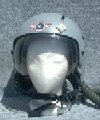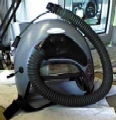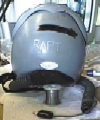The HGU-35/P was developed as an integrated helmet oxygen/communications system. The integral oxygen subsystem featured a new lightweight low-profile mask (Carleton mask), an integral oxygen duct through the helmet, and an external hose with communications wires connecting to the helmet at the rear. This configuration was meant to enhance aircrew performance under high "g" loading due to the reduction in mask weight and elimination of the front "elephant trunk" oxygen hose.
The HGU-35/P Operational Test and Evaluation was carried out in Spring 1979 as the final phase in test and evaluation before a production decision. Apparently the helmet did not meet expectations and the helmet was never put into production.







HGU-35/P in early configuration with a standard EEK-4/P visor housing. Note the oxygen hose is pointing downwards
from its exit at the rear of the helmet. In four of the pictures the so-called Carleton oxygen mask is visible. It was
developed especially for the HGU-35/P. Pictures © Gentex Corporation






HGU-35/P in later configuration with a new visor housing with an off-center visor lock knob. Note the oxygen hose
is pointing to the left. Pictures © Paul Taylor